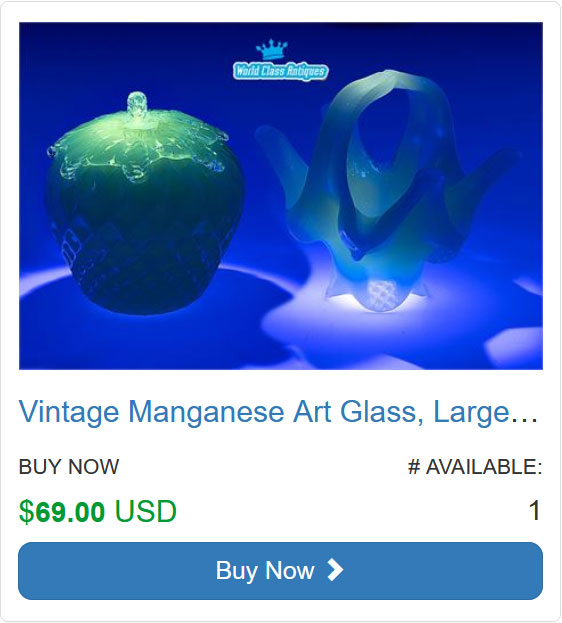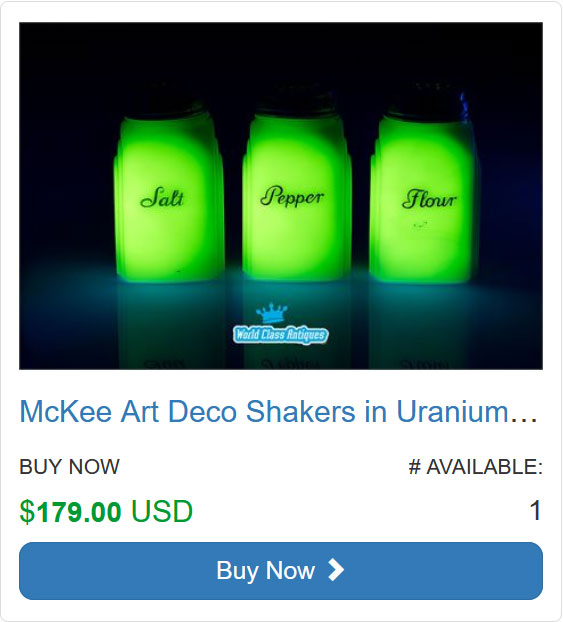Vintage glassware has a charm and uniqueness that captivates collectors and enthusiasts alike. Among the fascinating aspects of some these collectibles is their ability to glow under ultraviolet (UV) light. However, not all vintage glass glows for the same reason. In this blog post, we’ll explore the differences between glass containing manganese and glass containing uranium, and how each reacts under UV light. We will also provide images to visually distinguish between them.
- Understanding the Glow: Manganese Glass
- Spotting the Glow: Uranium Glass
- Testing the Waters: UV Light Sources
- Safety First: Handling Vintage Glass
- Conclusion: Unveiling the Beauty of Vintage Glass
Understanding the Glow: Manganese Glass
Vintage glass that contains manganese is known for its pink or purple hue when exposed to UV light. Manganese was commonly used as a decolorizer in glass production, and its presence results in a distinct response to UV rays. When subjected to a 365nm UV light source, manganese glass emits a soft, subtle glow, often appearing as a delicate lavender or light pink.
Manganese, when used as a decolorizer in glass, can also produce a faint greenish glow under certain UV light conditions. The primary characteristic associated with manganese in glass is its ability to generate a response to long-wave UV light, typically around 365nm. This response can sometimes result in a subtle greenish fluorescence, though it may not be as intense as the glow seen in glass containing uranium. See an example in our marketplace, in these lovely art glass pieces: A strawberry glass paperweight and a glass basket.

It’s important to note that, despite the fluorescence, manganese glass is not radioactive.
Spotting the Glow: Uranium Glass
On the other hand, uranium glass, commonly known as Vaseline glass, contains uranium oxide as a key component. This type of glass is renowned for its vibrant green or yellow glow under UV light. When exposed to a 365nm or 395nm UV light source, uranium glass emits a bright and distinctive fluorescence, ranging from a lively lime green to a rich, golden yellow. It’s worth noting that other types of glass, such as custard glass or Burmese glass, are also classified as Uranium glass, expanding beyond the commonly known Vaseline glass. Therefore, it’s important to recognize that Uranium glass encompasses various styles. For instance, an example of uranium glass that falls into the custard glass category is listed in our marketplace.

Testing the Waters: UV Light Sources
To differentiate between manganese and uranium glass, it’s essential to use the right UV light source. A 365nm UV light will reveal the subtle glow of manganese glass, while a 395nm UV light will showcase the vibrant fluorescence of uranium glass. Collectors and enthusiasts often carry both UV lights to fully appreciate and identify the unique characteristics of each piece in their collection.
Safety First: Handling Vintage Glass
While exploring the captivating glow of vintage glass under UV light is an exciting endeavor, it’s also generally considered safe. However, it’s always a good practice to handle glassware with care to avoid any potential risks associated with fragile antique items. While uranium glass does contain uranium oxide, the radiation levels are typically very low and considered safe for common handling and display. As a precaution, you may still choose to wear protective gloves to protect the glass and yourself. Enjoy the beauty of your vintage glass collection, and feel reassured that the associated risks with handling uranium glass are minimal.
Conclusion: Unveiling the Beauty of Vintage Glass
In the world of vintage glass, the glow under UV light adds an enchanting dimension to collecting and appreciating these timeless pieces. Understanding the differences between manganese and uranium glass allows enthusiasts to identify and appreciate the unique qualities of each, enhancing the joy of discovering and owning these vintage treasures.
As you explore your collection of glassware, bring out the UV lights to reveal the hidden beauty within each piece. In today’s community of vintage and antique glass collectors, there is a high interest in the captivating allure of glowing glass. Happy collecting!




Responses to “Unveiling the Glow: Manganese vs. Uranium in Vintage Glass”
Where can I buy a light for the Vaseline glass?
Manganese glass, I need a light for it.
This is the one we use.
All the best,
Support Team @ World Class Antiques